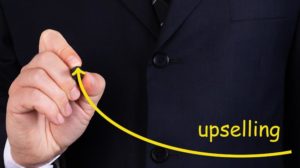Table of Contents
Whether cross-selling or upselling, customers in retail are prepared to spend more if you use the right strategies to appeal to them at the point of purchase. Your customer has already demonstrated buying behaviour, and you can use this moment to encourage them to increase the value of their interest in you. You can use many strategies to do this, and here we explore a few.
Upselling and Cross-selling in Retail
What is upselling?
Upselling is an approach that encourages the buyer to take a higher-priced option over the one that they intended to buy. In many ways, upselling is easier than cross-selling. You are not asking the buyer to buy more than they intended, but to buy a better version than they first thought.

The easiest example of upselling is the buyer who buys one model of car and is encouraged to buy the next one up. The higher-priced item seems reasonable, as it is only a little more than they had already committed to paying.
How can you upsell?
Knowing how to upsell is easy; developing the skill to succeed is an art. There is a rule of three to keep in mind when considering whether to upsell and how. First, use the product they had in mind to gauge willingness to buy something bigger and better. Work out what is only a slightly more expensive option. Then, find the dream option at a higher price but fulfils many more of the purchaser’s desires.
The aim would be to encourage the buyer to take the dream option, which is the ideal outcome for those upselling. However, even if they don’t, they are still more likely to buy the middle option.

To do this means knowing your products so well that you can work out what two other options to lay out for the buyer. You also need to engage your customers in conversation to get to know them. Before offering an upselling opportunity, you need to be clear on their intentions and goals of the purchase.
The main point here is that applying this approach is more difficult than it sounds. It requires the salesperson to pitch possibilities without being aggressive and to take the time to identify if the options being pitched are suitable.
What is cross-selling?
Cross-selling is about offering complementary items for the purchase being made. On a basic level, the batteries are displayed beside the electronic toothbrush or the wrapping paper with the luxury watches or birthday cards. When you head to the tills in a shoe shop, the store manager will display shoe polish and socks, reminding you that you need to get these items to maximise your purchase.
How can you cross-sell?
While displaying these products before the final checkout is a good option, it is not the only way to cross-sell to a customer. Another business strategy could be to make an additional sale a few days or weeks after the first commitment to a relationship with your brand. You can send drip emails to suggest further services or products that the customer may find appealing. These drip emails are a more subtle way of cross-selling, as you give the buyer time to make use of the first purchase before suggesting how they might enhance this with further engagement with you.
If you are working with clients over a longer period, you may wait to offer the cross-sell until you have built a relationship with them. When you understand their needs better, you are better positioned to tailor your offer to them.

Matching the service or products to the clients requires a strong understanding of their needs and making suggestions from the data you can uncover as you work with them. It is possible to set up your CRM to respond to certain data points and to act on your behalf, automating the cross-selling and maximising contact with the client.
The final option is to bundle, especially if virtual selling. Some products naturally come together and make obvious companion pieces. You can incentivise these cross-selling opportunities with a three-for-two promotion, which is especially popular when selling items such as shampoo, conditioners, and other hair products.
Conclusion
The money it takes to win a client through marketing and sales engagement needs to be recouped in the lifetime value of the customer. One purchase may offer a scant return for the cost of acquiring that customer. Therefore, to maximise the investment in winning this buyer, efforts to upsell and cross-sell are essential. While many believe that cross-selling with bundles and product placement is easier, often encouraging the buyer to choose the more expensive option is easier.
Author Profile

- Guest Blogger & Outreach Expert - Interested in Writing Blogs, Articles in Business Niche | News Journalist By Profession in the United Kingdom
Latest entries
 BusinessJuly 1, 2025Wills for Business Owners: Safeguarding Your Enterprise and Legacy
BusinessJuly 1, 2025Wills for Business Owners: Safeguarding Your Enterprise and Legacy Business TipsJune 6, 2025Confidence That Connects the Message
Business TipsJune 6, 2025Confidence That Connects the Message GamingMay 9, 2025Why AI Personalization Is Key for the Next Generation of Betting Platforms?
GamingMay 9, 2025Why AI Personalization Is Key for the Next Generation of Betting Platforms? Business StrategiesMay 1, 2025Key Business Development Strategies for Fostering Sustainable Growth
Business StrategiesMay 1, 2025Key Business Development Strategies for Fostering Sustainable Growth




